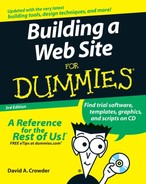Chapter 4. Working with WYSIWYG
In This Chapter |
|
WYSIWYG (What You See Is What You Get) programs are easy for novices to use in the early stages of Web site creation, but they can quickly prove less than satisfactory. The reason for both factors is the same: The program makes a bunch of choices for you. Although this feature may seem like a comfort at first, it can quickly become a limitation. If you go for a WYSIWYG program, make sure that it’s sophisticated enough that you can still use it as your skills advance.
Most WYSIWYG programs have at least some degree of depth beneath their surface simplicity. Dreamweaver (the topic of this chapter), for example, lets you set the attributes for every element, in case you don’t like the default choices, giving you the best of both worlds, allowing you to create visually while working under the hood with the base code. That means that you can enjoy both the quickness of WYSIWYG creation and the total control of text editing in the same page-creation session.
Dreamweaver, shown in Figure 4-1, is the main choice of most professional Web designers, but it isn’t the only possible choice. Table 4-1 lists several WYSIWYG programs that you can use to build Web pages, along with the Web addresses where you can find them (or information about them).
Figure 4-1. Dreamweaver is a full-featured WYSIWYG environment for building Web pages.

| Program | Web Address |
|---|---|
| Microsoft Expression Web | http://www.microsoft.com/Expression/products/overview.aspx?key=web |
| Adobe Dreamweaver | www.adobe.com/products/dreamweaver |
| HotDog PageWiz | www.sausage.com/hotdog-pagewiz.html |
| Web Studio | www.webstudio.com |
